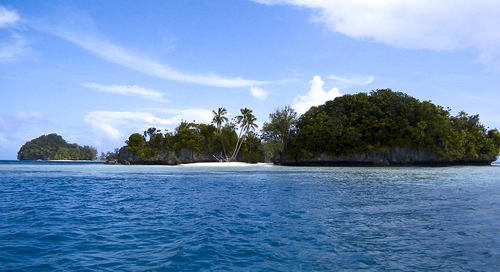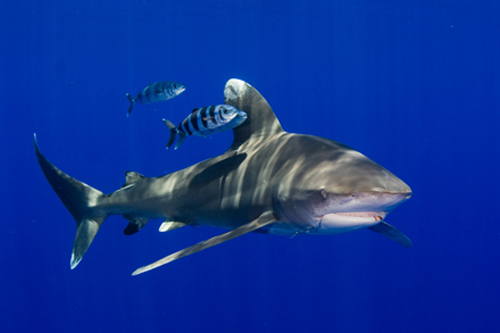Navigation
Sixth Largest Marine Protected Area In The World Created By Palau
On October 28, 2015, Tommy E. Remengesua, Jr., President of the Republic of Palau signed into law the “Palau National Marine Sanctuary Act,” creating “the sixth largest marine protected area in the world, while setting aside a zone for domestic fishing.” According to Nature Conservancy Palau supports more than 400 species of coral species and nearly 1,300 varieties of reef fish.
 Rock Islands, Palau: Photograph by Peter R. Binter. Courtesy of Wikipedia.
Rock Islands, Palau: Photograph by Peter R. Binter. Courtesy of Wikipedia.
On October 28, 2015, Tommy E. Remengesua, Jr., President of the Republic of Palau signed into law the “Palau National Marine Sanctuary Act,” creating “the sixth largest marine protected area in the world, while setting aside a zone for domestic fishing.”
In his letter to Palau Senate President Chin, Remengesua writes that the “people have come together to support the protection of our source of livelihood, identity and culture: our Ocean.
“Shifting our way of thinking,” his letter continues, “from merely allowing foreign interests to continue to harvest our limited resources; to protecting them for future generations is a necessary step we must take.”
“Science has also shown that by creating marine protected areas and allowing the marine life in those areas to regenerate, the ‘spill over’ also promotes the health of surrounding areas. Declaring 80% of our EEZ [Exclusive Economic Zone] will allow the marine life in that are to rebound and spill over into the 20% domestic fishing area where our local fishermen can then harvest them. This will alleviate some of the fishing pressure on our near shore reefs as well as create a healthy marine environment for our growing diving and sport-fishing industry.”
President Obama to the 2015 Our Ocean Conference
Many partners and previous Palauan endeavors are credited with making the Palau National Marine Sanctuary possible. Among them, the Nature Conservancy which says it has worked with Palau leaders and agencies for 25 years during which it supported the government in its work “as a key driver” of the creation of the Micronesian Challenge.
A National Geographic Society Report, “Marine Biodiversity and Protected Areas in Palau,” published in May, 2015, helped provide background for the establishment of the sanctuary. This Report on open ocean fishes around Palau and their survey of the surrounding sea down to 3,500m revealed “a diverse fish fauna including numerous sharks and schools of tunas. The number of species and individuals observed were comparable to the 640,000 km2 Chagos Marine Reserve in the Indian Ocean.
The Report stated that creation of a sanctuary around Palau would provide protection for these valuable pelagic resources, allowing them to grow larger, become more abundant, and generate higher reproductive output…This would benefit the fishing within and around Palau, and protect biodiversity by reducing by-catch of a wide range species critical to ecosystem function.
“Our deep-sea video cameras showed a diverse and rich fauna that included at least 26 different taxa of deep-water fishes from 19 families.”
 Oceanic white tip shark: Some species, such as the oceanic white tip, have experienced declines of up to 99 percent. Due to their life history characteristics of slow growth, late maturity, and production of few young, sharks are exceptionally vulnerable to overexploitation and slow to recover once depleted. Photograph by Jim Abernethy courtesy of the Pew Environment Group
Oceanic white tip shark: Some species, such as the oceanic white tip, have experienced declines of up to 99 percent. Due to their life history characteristics of slow growth, late maturity, and production of few young, sharks are exceptionally vulnerable to overexploitation and slow to recover once depleted. Photograph by Jim Abernethy courtesy of the Pew Environment Group
In another major effort, Palau, writes Remengesua, created the world’s first Shark Sanctuary and has been declared a World Heritage Site.
Resources:
The National Geographic Society Report can be read at http://palaugov.org/wp-content/uploads/2015/05/NAT-GEO-REPORT_PALAU_MAY_12_SING_LORES_RGB.pdf. It contains many pictures along with descriptions of their findings.
http://www.pimrisportal.org/mpas
http://www.icriforum.org/gcrmn
http://palaugov.org/ RPPL No. 9-49 Palau National Marine Sanctuary Act
marine biodiversity of the federated states of micronesia available at http://www.comfsm.fm/bchm/MarineBio.pdf
Micronesia: Ulithi, Yap, and Palau - Oceanic Society available at www.oceanicsociety.org/expeditions/micronesia-ulithi-yap-and-palau--67
See related articles on the Horizon International Solutions Site:
World's Second-Largest Shark Sanctuary Established by Federated States of Micronesia available at http://www.solutions-site.org/node/1475.
World’s Largest Shark Sanctuary Declared in Central Pacific available at http://www.solutions-site.org/node/529.
Scientists Find Coral Reefs Defy Ocean Acidification Odds in Palau: Palau reefs show few of the predicted responses available at http://www.solutions-site.org/node/1498.
Search
Latest articles
Agriculture
- World Water Week: Healthy ecosystems essential to human health: from coronavirus to malnutrition Online session Wednesday 24 August 17:00-18:20
- World Water Week: Healthy ecosystems essential to human health: from coronavirus to malnutrition Online session Wednesday 24 August 17:00-18:20
Air Pollution
- "Water and Sanitation-Related Diseases and the Changing Environment: Challenges, Interventions, and Preventive Measures" Volume 2 Is Now Available
- Global Innovation Exchange Co-Created by Horizon International, USAID, Bill and Melinda Gates Foundation and Others
Biodiversity
- It is time for international mobilization against climate change
- World Water Week: Healthy ecosystems essential to human health: from coronavirus to malnutrition Online session Wednesday 24 August 17:00-18:20
Desertification
- World Water Week: Healthy ecosystems essential to human health: from coronavirus to malnutrition Online session Wednesday 24 August 17:00-18:20
- UN Food Systems Summit Receives Over 1,200 Ideas to Help Meet Sustainable Development Goals
Endangered Species
- Mangrove Action Project Collaborates to Restore and Preserve Mangrove Ecosystems
- Coral Research in Palau offers a “Glimmer of Hope”
Energy
- Global Innovation Exchange Co-Created by Horizon International, USAID, Bill and Melinda Gates Foundation and Others
- Wildlife Preservation in Southeast Nova Scotia
Exhibits
- Global Innovation Exchange Co-Created by Horizon International, USAID, Bill and Melinda Gates Foundation and Others
- Coral Reefs
Forests
- NASA Satellites Reveal Major Shifts in Global Freshwater Updated June 2020
- Global Innovation Exchange Co-Created by Horizon International, USAID, Bill and Melinda Gates Foundation and Others
Global Climate Change
- It is time for international mobilization against climate change
- It is time for international mobilization against climate change
Global Health
- World Water Week: Healthy ecosystems essential to human health: from coronavirus to malnutrition Online session Wednesday 24 August 17:00-18:20
- More than 400 schoolgirls, family and teachers rescued from Afghanistan by small coalition
Industry
- "Water and Sanitation-Related Diseases and the Changing Environment: Challenges, Interventions, and Preventive Measures" Volume 2 Is Now Available
- Global Innovation Exchange Co-Created by Horizon International, USAID, Bill and Melinda Gates Foundation and Others
Natural Disaster Relief
- STOP ATTACKS ON HEALTH CARE IN UKRAINE
- Global Innovation Exchange Co-Created by Horizon International, USAID, Bill and Melinda Gates Foundation and Others
News and Special Reports
- World Water Week: Healthy ecosystems essential to human health: from coronavirus to malnutrition Online session Wednesday 24 August 17:00-18:20
- STOP ATTACKS ON HEALTH CARE IN UKRAINE
Oceans, Coral Reefs
- World Water Week: Healthy ecosystems essential to human health: from coronavirus to malnutrition Online session Wednesday 24 August 17:00-18:20
- Mangrove Action Project Collaborates to Restore and Preserve Mangrove Ecosystems
Pollution
- Zakaria Ouedraogo of Burkina Faso Produces Film “Nzoue Fiyen: Water Not Drinkable”
- "Water and Sanitation-Related Diseases and the Changing Environment: Challenges, Interventions, and Preventive Measures" Volume 2 Is Now Available
Population
- "Water and Sanitation-Related Diseases and the Changing Environment: Challenges, Interventions, and Preventive Measures" Volume 2 Is Now Available
- "Water and Sanitation-Related Diseases and the Changing Environment: Challenges, Interventions, and Preventive Measures" Volume 2 Is Now Available
Public Health
- Honouring the visionary behind India’s sanitation revolution
- Honouring the visionary behind India’s sanitation revolution
Rivers
- World Water Week: Healthy ecosystems essential to human health: from coronavirus to malnutrition Online session Wednesday 24 August 17:00-18:20
- Mangrove Action Project Collaborates to Restore and Preserve Mangrove Ecosystems
Sanitation
- Honouring the visionary behind India’s sanitation revolution
- Honouring the visionary behind India’s sanitation revolution
Toxic Chemicals
- "Water and Sanitation-Related Diseases and the Changing Environment: Challenges, Interventions, and Preventive Measures" Volume 2 Is Now Available
- Actions to Prevent Polluted Drinking Water in the United States
Transportation
- "Water and Sanitation-Related Diseases and the Changing Environment: Challenges, Interventions, and Preventive Measures" Volume 2 Is Now Available
- Urbanization Provides Opportunities for Transition to a Green Economy, Says New Report
Waste Management
- Honouring the visionary behind India’s sanitation revolution
- Honouring the visionary behind India’s sanitation revolution
Water
- Honouring the visionary behind India’s sanitation revolution
- Honouring the visionary behind India’s sanitation revolution
Water and Sanitation
- Honouring the visionary behind India’s sanitation revolution
- Honouring the visionary behind India’s sanitation revolution

